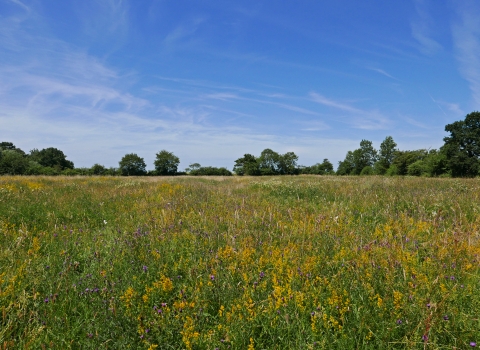Maytime is to the meadows coming in,
And cowslip peeps have gotten eer so big,
And water blobs and all their golden kin
Crowd round the shallows by the striding brig.
Daisies and buttercups and ladysmocks
Are all abouten shining here and there,
Nodding about their gold and yellow locks
Like morts of folken flocking at a fair.
John Clare, Sport in the Meadow
Britain's wildflower meadows have been used by writers and artists for centuries to convey a sense of rural idyll and to celebrate our traditional countryside. But what is a meadow, why are they special and do we still have them?
What is a meadow?
The word meadow comes from the Old English mædwe, which derives from mæþ meaning 'mown' and refers to a field where the grass is cut in summer. Meadows are different from pasture, which are areas of grass that are not cut and instead just grazed by livestock.
Traditionally meadows were areas of grassland used for hay making. Hay that was gathered from the meadow after it was cut was used later in the year to feed livestock through the winter and is a practice still used today.
Why are they so important?
Traditional hay meadows contain a huge diversity of plant species and support an array of invertebrate, bird and mammal species. This is because hay making removes a large amount of biomass from the grassland and prevents the accumulation of nutrients that would otherwise occur. Reducing nutrient levels is good for wildflowers because most wildflower species prefer nutrient poor environments.
For centuries traditional hay meadows were a common sight across Britain but since the advent of agricultural intensification they have dramatically declined by 97% and the wildlife that depends on them has suffered. The few that remain have become oases for wildlife.
When are meadows cut?
Traditionally hay was cut just as it began to set seed because it created hay with a high nutritional value for livestock to eat. Removing these nutrients also provided the best environment for wildflowers. Latitude, altitude and yearly weather conditions can all affect the time of the hay cut. Hay making on floodplain meadows traditionally started around Midsummer’s Day (24 June) or even earlier.
As meadows were cut with scythes it was often a time consuming process that could take weeks. Today we use machines, which is much quicker but replicating the staggered approach of ancient hay cuts can provide refuges for wildlife and may also improve botanical diversity.
How old are our meadows?
The Wildlife Trust BCN manages a mix of old and newly restored meadows. Some are very ancient like Boddington Meadow in Northamptonshire which has never been ploughed. Bugbrooke Meadow is known as a charity meadow as it used to be owned by the village to provide free hay for the village poor, a practice that may go back over a hundred years.
Parts of Upwood Meadows in Cambridgeshire have been grassland since at least 1757 but may be much older. In Houghton Meadows cultivation of the site stopped in the 14th and 15th centuries, when the population fell as a result of the Black Death, and the fields became self-sown grassland (this may have occurred at Upwood Meadows too).
Why both graze and mow?
Meadows are also used to graze livestock. Grazing animals help improve the diversity of wildflower species by providing areas of open soil for seeds to set into and reducing the dominance of bulky species. On our nature reserves we use both sheep and cows to help us manage our wildflower meadows.
Climate change
Traditional hay meadows store large amounts of greenhouse gases in the rich array of vegetation that compose them. Across the world grasslands are in decline and their disappearance is one of the greatest causes of greenhouse gas accumulation in the atmosphere.
Find out more
Read the Floodplain Meadows Technical Handbook for detailed knowledge about traditional floodplain meadows.
Upwood Meadows - Robert Enderby
Summer wildflowers
Discover what wildflowers to look out for and where you can find our best wildflower nature reserves.
Highland cow at NW by Daisy Moser

